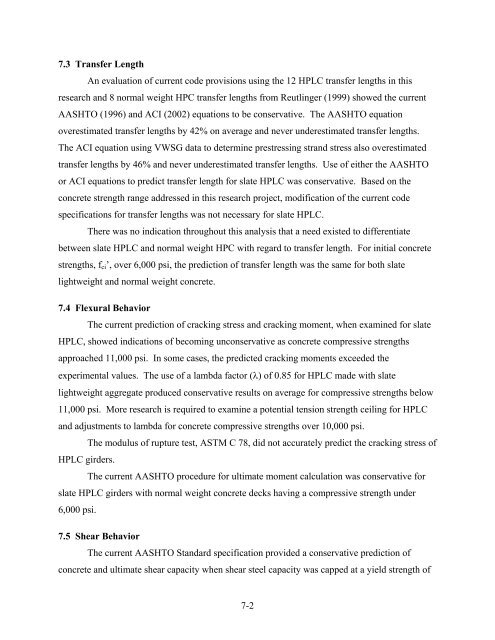Lightweight Concrete for High Strength - Expanded Shale & Clay
Lightweight Concrete for High Strength - Expanded Shale & Clay
Lightweight Concrete for High Strength - Expanded Shale & Clay
You also want an ePaper? Increase the reach of your titles
YUMPU automatically turns print PDFs into web optimized ePapers that Google loves.
7.3 Transfer Length<br />
An evaluation of current code provisions using the 12 HPLC transfer lengths in this<br />
research and 8 normal weight HPC transfer lengths from Reutlinger (1999) showed the current<br />
AASHTO (1996) and ACI (2002) equations to be conservative. The AASHTO equation<br />
overestimated transfer lengths by 42% on average and never underestimated transfer lengths.<br />
The ACI equation using VWSG data to determine prestressing strand stress also overestimated<br />
transfer lengths by 46% and never underestimated transfer lengths. Use of either the AASHTO<br />
or ACI equations to predict transfer length <strong>for</strong> slate HPLC was conservative. Based on the<br />
concrete strength range addressed in this research project, modification of the current code<br />
specifications <strong>for</strong> transfer lengths was not necessary <strong>for</strong> slate HPLC.<br />
There was no indication throughout this analysis that a need existed to differentiate<br />
between slate HPLC and normal weight HPC with regard to transfer length. For initial concrete<br />
strengths, f ci ’, over 6,000 psi, the prediction of transfer length was the same <strong>for</strong> both slate<br />
lightweight and normal weight concrete.<br />
7.4 Flexural Behavior<br />
The current prediction of cracking stress and cracking moment, when examined <strong>for</strong> slate<br />
HPLC, showed indications of becoming unconservative as concrete compressive strengths<br />
approached 11,000 psi. In some cases, the predicted cracking moments exceeded the<br />
experimental values. The use of a lambda factor (λ) of 0.85 <strong>for</strong> HPLC made with slate<br />
lightweight aggregate produced conservative results on average <strong>for</strong> compressive strengths below<br />
11,000 psi. More research is required to examine a potential tension strength ceiling <strong>for</strong> HPLC<br />
and adjustments to lambda <strong>for</strong> concrete compressive strengths over 10,000 psi.<br />
The modulus of rupture test, ASTM C 78, did not accurately predict the cracking stress of<br />
HPLC girders.<br />
The current AASHTO procedure <strong>for</strong> ultimate moment calculation was conservative <strong>for</strong><br />
slate HPLC girders with normal weight concrete decks having a compressive strength under<br />
6,000 psi.<br />
7.5 Shear Behavior<br />
The current AASHTO Standard specification provided a conservative prediction of<br />
concrete and ultimate shear capacity when shear steel capacity was capped at a yield strength of<br />
7-2















